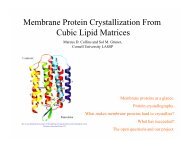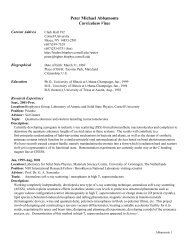Morphology and Gas Adsorption Properties of ... - ResearchGate
Morphology and Gas Adsorption Properties of ... - ResearchGate
Morphology and Gas Adsorption Properties of ... - ResearchGate
Create successful ePaper yourself
Turn your PDF publications into a flip-book with our unique Google optimized e-Paper software.
<strong>Morphology</strong> <strong>of</strong> Palladium-Cobalt-Based Cyanogels Chem. Mater., Vol. 15, No. 22, 2003 4243sampleTable 1. Surface Areas <strong>and</strong> Micropore Volumes <strong>of</strong> the 0.4 M Pd-Co CyanogelsN 2-S BETa(m 2 /g)N 2-S DRb(m 2 /g)CO 2-S DRb(m 2 /g)N 2-V pc(cm 3 /g)N 2-V DRd(cm 3 /g)CO 2-V DRd(cm 3 /g)0.4 M aerogel 730.71 ( 3.29 450.62 ( 3.17 822.82 ( 5.14 2.37 ( 0.17 0.23 ( 0.05 0.26 ( 0.050.4 M xerogel 439.36 ( 4.17 491.78 ( 3.84 705.11 ( 4.93 0.22 ( 0.07 0.19 ( 0.04 0.28 ( 0.06a N 2-S BET. Total surface area determined by applying the Brunauer-Emmett-Teller (BET) equation to the nitrogen adsorption data.b N 2-S DR <strong>and</strong> CO 2-S DR. Surface area <strong>of</strong> the micropore region determined by applying the Dubinin-Radushkevich equation to the nitrogen<strong>and</strong> carbon dioxide adsorption data. c N 2-V p. Total pore volume determined by measuring the volume <strong>of</strong> nitrogen absorbed at the saturationpressure <strong>of</strong> N 2. d N 2-V DR <strong>and</strong> CO 2-V DR. Micropore pore volume determined by applying the Dubinin-Radushkevich equation to thenitrogen <strong>and</strong> carbon dioxide adsorption data.Figure 5. Transmission electron microscope image <strong>of</strong> a 0.4MPd-Co xerogel. The particle size averages ∼10 nm.Figure 6. t-Plot for the 0.4 M Pd-Co aerogel showing boththe mesoporosity <strong>and</strong> the microporosity (inset). The pronouncedcurvature in the low-t region (inset) is indicative <strong>of</strong>microporosity in the aerogel.although the mean pore radius in the Pd-Co cyanogelsis highly sensitive to the gel concentration, the porosityis very weakly dependent on gel concentration: it variesby less than 5% when the concentration is varied by afactor <strong>of</strong> 5. The final evidence for microporosity in Pd-Co aerogels is provided by the t-plot analysis <strong>of</strong> theaerogel isotherm. Figure 6 shows the t-plot for the 0.4MPd-Co aerogel. The curvature in the t-plot in theregion <strong>of</strong> low t values clearly attests to the presence <strong>of</strong>microporosity in the Pd-Co aerogels.Unlike the N 2 adsorption isotherm for the xerogel,which is <strong>of</strong> Type I, the N 2 adsorption isotherm for the0.4MPd-Co aerogel is a type IV isotherm, 15 characteristic<strong>of</strong> a mesoporous solid (cf. Figure 2(b)). Theisotherm displays hysteresis: the H1 hysteresis loop isFigure 7. Scanning electron micrograph <strong>of</strong> a 0.4 M Pd-Coaerogel illustrating the “packed cotton ball” model. The“packed cotton ball” refers to the micropore-containing aerogelparticles that, on average, are ∼40 nm in diameter. Theinterstitial voids that arise from packing <strong>of</strong> these aerogelparticles constitute the mesopores.Table 2. Comparison <strong>of</strong> Sorption Data, Beam BendingData, <strong>and</strong> Calculated Estimatestype <strong>of</strong>measurementperformedon aerogelpermeabilitymeasurementnitrogen sorptionexperimentcalculatedvalues due to N 2sorption shrinkagedensity <strong>of</strong>aerogel(g/cm 3 )mean poreradius awithinaerogel (nm)total porevolume <strong>of</strong>aerogel(cm 3 /g)0.10 ( 0.02 17.1 ( 1.8 9.36 ( 1.836.48 ( 1.28 2.37 ( 0.460.28 ( 0.05 5.98 ( 1.17 3.08 ( 0.55a Mean pore radius found from the nitrogen sorption experimentwas determined by (2 × volume <strong>of</strong> N 2 adsorbed)/(BET surfacearea).characteristic <strong>of</strong> capillary condensation in mesopores.Such a loop is <strong>of</strong>ten obtained with agglomerates orcompacts <strong>of</strong> spherical particles <strong>of</strong> fairly uniform size <strong>and</strong>is typical <strong>of</strong> aerogels. 15Scanning electron microscope images <strong>of</strong> the 0.4 Maerogel, Figure 7, indicate that it is composed <strong>of</strong>spherical particles <strong>of</strong> 40 ( 3 nm in diameter. The meanpore radius calculated from the three-point beam bendingmeasurements 6 is 17.1 ( 1.8 nm. This value is insharp contradiction with the mean pore radius calculatedfrom the N 2 desorption which yields a significantlysmaller pore radius <strong>of</strong> 6.48 ( 1.28 nm. Table 2 lists thevalues <strong>of</strong> mean pore radius <strong>and</strong> pore volume obtainedthrough different techniques. The discrepancy betweenthe pore values obtained from the N 2 adsorption <strong>and</strong>from beam-bending measurements is not surprisingbecause gas adsorption is expected to significantlydeform the shape <strong>and</strong> size <strong>of</strong> pores in these compliantaerogels. As the liquid adsorbate begins to desorb fromthe pores, high capillary pressure gradients 22 that are









